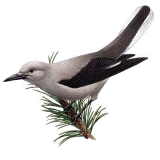Papers in the Biological Sciences
Date of this Version
2001
Abstract
Clark’s nutcrackers (Nucifraga columbiana) are capable of very precise searching using the metric relationships between a goal and multiple landmarks to relocate the goal location. They can judge the direction more accurately than the distance to a landmark when the landmark is distant from the goal. On the basis of these findings, we propose that nutcrackers use a set of bearings, each a measure of the direction from the goal to a different landmark, when searching for that goal. The results of a simulation demonstrate that increasing the number of landmarks used results in increasingly precise searching. This multiple-bearings hypothesis makes a series of detailed predictions about how the distribution of searches will vary as a function of the geometry of the locations of the relevant landmarks and the goal. It also suggests an explanation for inconsistencies in the literature on the effects of clock-shifts on searching and on homing.


Comments
Published in The Journal of Experimental Biology 2043, 103–113 (2001) Printed in Great Britain © The Company of Biologists Limited 2001. Used by permission.